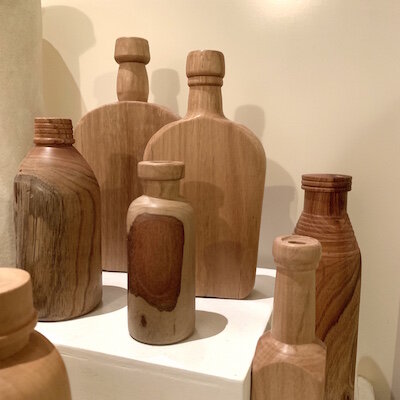My entry for Home Affairs 2019 titled “Ten Green bottles” is an ode to my fathers amazing antique bottle collection. It opened on Friday night.
My father’s collection of more than 400 bottles, mainly glass but some ceramic, sit on shelves on his kitchen walls. Many were found in the sandy shores of Sydney Harbour, whilst others were found in historic towns. All sorts of shapes and forms, some still with barnacles, others broken, the most colourful ones are on the window sill, showing off their gorgeous colours.
I decided to make my bottles in ceramic and wood because a few years ago I joined the Northern Beaches Woodturners and after learning the basics, I began playing, allowing found bits of wood to evolve into solid forms as opposed to the open vessels I was learning to make in ceramics.
Around the same time as I was learning woodturning, several trees in my father-in-laws garden mysteriously died. Tall rainforest trees planted by my husband from seeds and cuttings he’d collected over 30 years ago, including a red cedar and a macadamia nut tree. Whilst some of them were cut down and chipped, others were too good, too rare where I live to be thrown away, so I kept some branches and dried them out. They were not wide enough to make into bowls, but perfect proportions to turn into bottles.
As part of my ceramics diploma I learnt how to make terra sigillata, an ancient method of making glaze from clay. I love the smooth finish it gives and whilst most people try to keep its sheen by low firing, I wanted a matt finish similar to my fathers antique ceramic bottles. Clay looks more clay-like without a glass glaze, so I dug up some clay in my father-in-law’s home as well as near my home to make an even sweeter connection to the theme of Home. This year I joined Tramshed Potters and fires my bottles there.
What’s wonderful about this exhibition, is it’s a “process” exhibition, it’s all about discovering as you create. I was excited to be selected back in May and have learnt, so much about wood, it’s different grains, medullary rays and how some woods look better in cross grain and some in long. Some are easier to turn and are light as a feather, whilst others are dense, heavy logs. My mother had a passion for restoring Georgian furniture, so it’s been lovely to share her love of wood.
So too, I’ve learnt how hard it is to throw a thin necked bottle, getting all that clay from a large to a small diameter and even harder the taller it gets. I grew up in Bath and this year I was lucky enough to tour several UK potteries as well as ceramic and furniture galleries including the V&A in London, Vietri sul Mare, Valencia, the design museum in Denmark and others in Holland. I have new understanding and respect for design, designers, makers and collectors of everyday objects we use in our lives and it was special to see the bottles created by artists like Gwen Hanson-Piggot & Edmund de Waal and admire their exquisite, light forms.
I’ve also learnt why many bottles are made of glass but I can’t help but realise how much plastic we use in our lives. Whilst I took measurements of some of my fathers antique bottles, my hands seemed to intuitively want to make more contemporary forms with plastic lids. I hope Ten green bottles will prompt some viewers to consider what we use in our modern homes.
Home Affairs 2019 is on until Sun 1st December 2019, Manly Gallery, West Esplanade, Manly and “Ten green bottles is for sale as one installation, three separate still life’s or individually, please email me or contact the gallery.
There are more photos of the making on my Instagram stories and for more insights on my creative endeavours, news and where to find my work, sign up to my newsletter.






